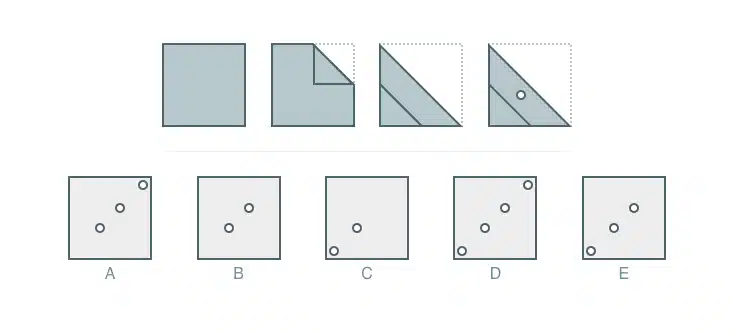Spatial visualization, also called spatial intelligence, is a measure of the ability to look at a two-dimensional figure and visualize what it would look like, expanded into three dimensions. You can rotate it in your mind without any physical, tangible pieces in front of you.
In this post, we’ll talk about what spatial visualization is, the characteristics of people who have a strong aptitude for 3D visualization, and what kind of careers are a great fit for them.
Spatial visualization is an aptitude
The ability to look at something in two dimensions, such as a map, and visualize it in three dimensions, is called spatial visualization. Every person on the planet has this aptitude to some degree, such as being able to visualize where a button needs to be sewn onto a shirt, or how a tree will look planted in a spot in the backyard. But people with a natural ease for interacting with ideas and abstract thinking, without a specific physical visual may find they have a higher aptitude for spatial visualization.
People with this trait are called “3D visualizers.” They can take a 2D representation, such as illustrated instructions or blueprints, and create a 3D model in their mind. When new information becomes available, they can easily adjust their mental models without having to create them physically. They can visualize how objects would most effectively be organized in a given space.
People with a spatial visualization aptitude for 3D visualization can process information by drawing diagrams to understand new concepts quickly. Pictures, tables, and figures help them understand a concept more effectively than written text.
In addition to 3D visualizers, there are two other types of spatial visualizers:
- Abstract thinkers: Abstract thinkers are pulled toward abstract roles, such as counseling, teaching, law, literature, or the political process. Abstract concepts involving ideas, relationships, and feelings are within easy grasp. They feel less comfortable with new technology or information if mastering it requires using images. When dealing with physical structures, they tend to be impressed by the fine details rather than the overall design.
- Space planners: Space planners are comfortable reading maps, blueprints, or diagrams. They can usually visualize how objects would most effectively be organized in a given space. They retain new information presented visually via pictures, tables, or graphs.|
How do you know what your aptitude for spatial visualization is?
Everyone uses some form of spatial visualization every day. But, like all aptitudes, some have a deeper bent for one type of this aptitude than others. If seeing something in your mind before it’s physically in front of you comes easily, your aptitude for spatial visualization may be that of a 3D visualizer.
However, people who have a hard time understanding a concept without something tangible in front of them most likely do not have a strong aptitude for spatial visualization. These types of people often call themselves “visual learners.”
People with a spatial visualization aptitude for 3D visualization excel at:
- Classes like biology, physics, and design, as well as trigonometry, calculus, and architecture
- Artistic and hands-on hobbies
- Packing and organizing things into spaces
- Video games that let the player create imaginary worlds, or simulate past and future cities
Spatial visualizers who are 3D visualizers may have difficulty with:
- Formal lectures and group work sessions
- Understanding historical dates, politics, or philosophy
- Promoting ideas without using visual language or props
- Following the plot of a story that lacks video imagery, such as audio books, or movies with poorly edited cuts
Ideal careers for 3D visualizers
Architecture, engineering, and carpentry are all fields that benefit from strong spatial visualization skills, as reading blueprints and maps are critical in these fields.
Other fields that spatial visualizers excel in are medicine, applied health or physical sciences, and even interior or landscape design. The ability to imagine that retro 1970s olive green kitchen into a modern, top-of-the-line cooking space is a great example of spatial visualization!
Spatial visualization isn’t just for those who are good with data. For those with a more creative turn of mind, artistic endeavors also fit the bill. If you excel at being able to visualize colors and shapes on a blank canvas, or a complicated dance sequence from hearing a piece of music on an empty stage, you probably have an aptitude for spatial visualization. Michelangelo was able to see the great David statue from a block of marble! Spatial visualization careers in the arts include designing theater, TV, and film sets, costume design, and installing art collections for galleries and museums.
Even those with a taste for mystery and police work can use their aptitude for spatial visualization: traffic accident and crime scene reconstruction isn’t just seen on TV shows like CSI, Law and Order, or any crime-solving caper. The ability to take in the clues and visualize what happened in your mind is a strong asset in becoming a crime scene investigator.
Career outlook
There seems to be a career for any interest if you have a bent for spatial visualization! From those who love numbers and building, to those with creative and artistic flair, there are jobs for anyone. Here’s a few careers to consider if you have an aptitude for spatial visualization.
Architect
Traditional architects prepare detailed drawings of architectural and structural features of buildings or drawings and topographical relief maps used in civil engineering products, such as highways, bridges, and public works. Other jobs that utilize architecture skills include landscape architects, naval architects, naval engineers, and web developers.
- Median wage: $83,000
- Job outlook: 6.9 % growth
Civil engineer
Like architects, there are many types of engineers. A civil engineer performs engineering duties in planning, designing, and overseeing construction and maintenance of building structures and facilities, such as roads, railroads, bridges, harbors, channels, dams, irrigation projects, pipelines, power plants, and water and sewage systems. Other engineering fields include agriculture, chemical, environmental, electrical, mechanical, and many more.
- Median wage: $88,0650
- Job outlook: 8.4% growth
Interior designer
Interior designers plan, design, and furnish the internal space of rooms or buildings. They design interior environments or create physical layouts that are practical, aesthetic, and conducive to the intended purposes.
- Median wage: $60,340
- Job outlook: 3.8% growth
Art director
This is a broad title that applies to a number of different areas. An art director formulates design concepts and presentation approaches for visual productions and media, such as print, broadcasting, video, and film. They direct workers engaged in artwork or layout design.
- Median wage: $100,890
- Job outlook: 10–15% growth
Crime scene investigator (CSI)
Crime Scene Investigators can also be called forensic science technicians, detectives, and have expertise in areas like ballistics, fingerprinting, handwriting, and biochemistry. Their main duties include collecting, identifying, classifying, and analyzing physical evidence related to criminal investigations.
- Median wage: $61,930
- Job outlook: 15%+ growth
Can I enhance my spatial visualization abilities?
Aptitudes are abilities people are wired with. They solidify by about age 14.
You can practice your spatial visualization abilities just like you might practice a skill and make it even stronger.
Some psychologists believe that young children’s spatial skills can be influenced from a young age, through a series of exercises. Much like reading to young children enhances cognitive development and abilities, these exercises may enhance spatial visualization skills for those naturally wired to be visualizers already..
Some engineering schools require a spatial visualization test before entering. Participants who do poorly are required to take a spatial visualization skills course before they’re admitted.
Interestingly, a study showed that video games have an effect on spatial visualizations, although every parent probably wishes there was an alternative! And those without a leaning toward 3D visualization won’t likely ever catch up to those with one.
How do I know what my aptitude for spatial visualization is?
It’s easy to find out what your aptitude for spatial visualization is through a simple aptitude assessment that uncovers your natural ability.
- YouScience® Aptitude & Career Discovery offers an aptitude-based college and career readiness assessment. It uses brain-game-like exercises to uncover aptitudes for idea generation, visual comparison speed, spatial visualization, numerical reasoning, and more.
The Paper folding exercise- In this exercise, you match a folded piece of paper with holes punched in it to an unfolded piece of paper.
- The Mental Rotation exercise: This exercise presents the test-taker with shapes that are then rotated to achieve a certain goal. The participant must choose which shape matches the goal.
These exercises help determine your unique aptitude toward spatial visualization. If you find them frustrating, most likely, your best aptitudes lie elsewhere.
How to prepare for an aptitude assessment
Since an aptitude is a natural ability, there’s really no way to prepare for an aptitude test. Just be yourself!
Discovery helps you discover your abilities to find out the type of jobs that they will perform well in and find satisfying, not just something they find mildly interesting. It’s difficult to cheat, but don’t do it– you could wind up with the wrong assessment, and in a job you’re not cut out for.







